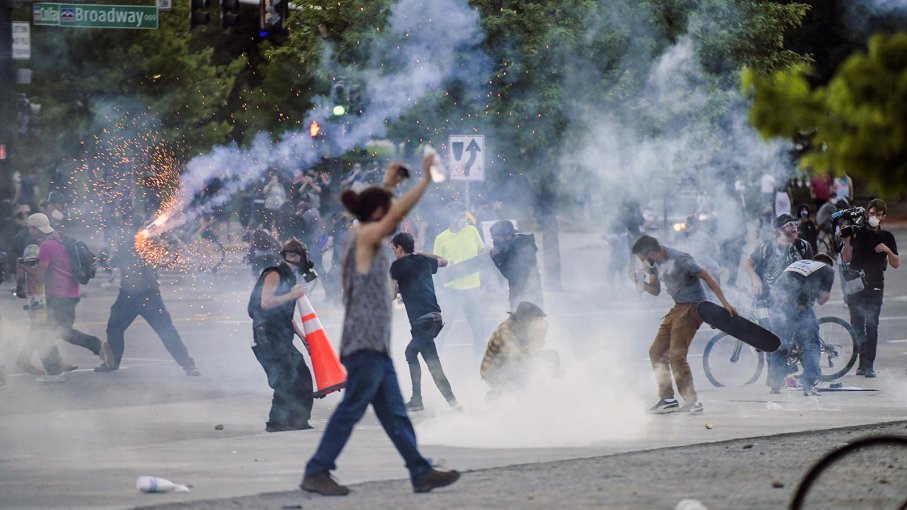Tear Gas Used at Protests May Help Spread Coronavirus

By now we’ve all seen the pictures: enormous crowds of protesters in the U.S. met with, in some cases, ominous clouds of tear gas. But the use of tear gas to disperse protesters in cities in the United States and around the world could have unintended consequences when it comes to the spread of the coronavirus.
The large crowds that have gathered to demonstrate for racial justice and against police brutality in the weeks after the death of George Floyd in Minneapolis in late May were already worrisome to public health officials. Although many demonstrators wore masks, most crowds grew much too large to maintain social distancing guidelines. Also, the protests typically involved crowds of people shouting and chanting, activities that could potentially send infected droplets far and wide.
Tear Gas and Coronavirus
The sight alarmed Amber Schmidtke, Ph.D., an assistant professor of microbiology in the department of biomedical sciences at Mercer University’s School of Medicine in Macon, Georgia.
“Tear gas components are mainly there to hit the pain receptors in your body to get you to move,” she says. “It’s like you’re poked with a stick. You want to get away from the pain. The other thing [tear gas] does is trigger your parasympathetic response, a neurologic series of activities that are outside of your control, but because there’s a chemical irritant in place your body is going to do everything it can to flush it out.”
A person will feel the symptoms of chlorobenzylidene malononitrile (CS), chloroacetophenone (CN) and dibenzoxazepine (CR) — the chemicals most commonly used in tear gas — within 20 to 30 seconds after being exposed.
“It’s going to increase mucous production along the sites where you’ve had exposure and that’s mainly your respiratory mucosa linings,” Schmidtke says. “In your nose that means you’ll have a runny nose. You’re going to have mucus production in the lungs, along the trachea, your windpipe. You’re going to want to cough that out. You’re also going to want to salivate more than you ordinarily would; you’re going to produce more tears.”
How much a person is affected depends on many variables, such as whether there’s a breeze or how close they are to the agent. A person’s eyes will sting, they may sneeze or retch.
“But the most dangerous thing is the coughing that will happen in response to the tear gas,” Schmidtke says. “It’s a deep cough because you are trying so hard to get this out of your body. And it has the potential to spread viral particles rather far. It’s your body’s natural response to get rid of a chemical irritant but it’s the same mechanism that we’re concerned about with virus spread. It’s the perfect storm of things you don’t want to happen in a pandemic.”
And it’s not just Schmidtke who is concerned. Other public health officials are too, including Centers for Disease Control director Dr. Robert Redfield who said during a June 4, 2020, House Appropriations hearing on the coronavirus response that the use of tear gas by police may help the virus spread.
tear gas
Police officers in riot gear push back demonstrators next to St. John’s Episcopal Church outside of the White House by shooting tear gas on June 1, 2020 in Washington D.C.
JOSE LUIS MAGANA/AFP VIA GETTY IMAGES
What Tear Gas Feels Like
Forrest Brown lives in downtown Atlanta just two blocks from CNN and Centennial Olympic Park, close to the site of many Atlanta protests. The first weekend of demonstrations, he stood outside his building with neighbors attempting to protect their property when he got a whiff of a pungent odor: tear gas.
“We could smell it and it stung our eyes,” Brown says. “We would go inside, wait it out, but it wasn’t a strong hit. You could feel it but then it dissipated.”
That was Saturday, May 30, 2020. Sunday night was a different story.
“I was actually in the interior courtyard of our building,” Brown says. “I didn’t see the [cloud] but it was a bad dose compared to Saturday night. My symptoms were much worse — stinging and watering eyes; it also made my lips feel like they were tingling and burning. I felt like I wanted to throw up. It made me feel very weak, almost jittery like I might pass out.”
Brown says the worst of it was over in about 30 minutes, though he felt nauseous for several hours and even had blurred vision Monday.
Though he was wearing a mask (following standard protocols) and a full block away from where the tear gas was actually released, he was exposed to it — and he believes possibly coronavirus, something he says he is definitely concerned about.
“Because I was wearing a mask and was outdoors, and some of the protesters wore masks — plus it was warm and no one lingered for long — I’m hoping all that together means I’m OK,” Brown says. “[Before this] I was very closely following coronavirus protocols and that has been totally thrown out the window with this.”
Risks for Coronavirus Skyrocket for Protesters
The use of tear gas at demonstrations during the pandemic is of concern to Schmidtke, not only because it potentially increases the spread of the coronavirus, but also because the same people who were at risk for a COVID-19 infection are also at risk for side effects from a tear gas exposure: those people with underlying conditions.
“COVID-19 sort of blurs the lines between being a respiratory disease and a cardiovascular disease,” she says. “The similarities aren’t uniform but if you have asthma, you’re going to be at higher risk of complications from something like a tear gas exposure. People who have COPD or any of those sorts of ailments could have more severe outcomes.”
Schmidtke concedes it’s a difficult situation because a person can make plans to participate in a peaceful protest and find themselves in a situation they aren’t prepared for.
“The biggest bottom line is that if you’re a protester and you’re exposed to tear gas — even if you weren’t — you need to make a plan to be tested for COVID-19 because we know you were in a setting with a lot of people,” Schmidtke says.
But, she says, there’s no real incentive to get tested immediately after protesting. When the virus gets into the body it goes into what’s called the eclipse period, hiding out in the cells while it makes copies of itself. Then it starts to leave the cells and spread to other cells. “While it’s in the cells it’s undetectable,” she says.
Schmidtke suggests everyone who has been at a protest rally should get tested within three to seven days of participating, even if they’re not showing symptoms, because of the high rate of asymptomatic carriers.
CDC director Redfield issued a similar warning at the June 4 Senate Appropriations hearing. “I do think there is a potential, unfortunately, for this to be a seeding event,” he testified. He went on to advise anyone who has attended protests to be tested within three to seven days, and to caution anyone they come in contact with that they may have been exposed to the virus.
Protesters do have some things going for them,” Schmidtke says. “They’re outside, they have the benefit of ventilation. They have sunlight. We know UV light is not advantageous for the virus. Protesters are typically young. But I wouldn’t count on those things being some sort of anti-COVID security blanket at all.”



 Creators of mankind
Creators of mankind Description of “Tall white aliens”
Description of “Tall white aliens” Where they came from?
Where they came from? About hostile civilizations
About hostile civilizations The war for the Earth
The war for the Earth “Tall white aliens” about eternal life
“Tall white aliens” about eternal life Video: “Nordic aliens”
Video: “Nordic aliens” Aliens
Aliens Alien encounters
Alien encounters The aliens base
The aliens base UFO
UFO Technology UFO
Technology UFO Underground civilization
Underground civilization Ancient alien artifacts
Ancient alien artifacts Military and UFO
Military and UFO Mysteries and hypotheses
Mysteries and hypotheses Scientific facts
Scientific facts


















